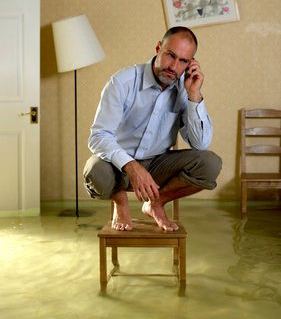What to Do When Your Roof Starts Leaking – Roof Repair Tips
The spring season is finally almost upon us which for much of the country means that the snow will be melting and the amount of rainfall will increase. The heavy rains of the spring may cause problems around a home such as floodingFlooding is the overflow or accumulation of water in areas t... More or a leaking roof and homeowners should be constantly looking out for these problems, especially during a rain storm. If you discover that your roof is leaking, it is important to take these following actions to prevent water damage in your home.
Leaking Roof Repair Tips and Recommended Actions
Immediately Control the Damage: As soon as the leak is discovered, move any furniture or personal belongings away from the leak to prevent them from getting water damage. Any items or furniture that is too large to move should be covered with plastic sheets. Place a leak proof container under the leak to catch the dripping water.
Remove Excess Water: Remove as much excess water as possible by mopping or blot dryingDrying is the process of removing moisture from materials, s... More wet furniture and carpeting. Wet carpeting may need to be pulled up to allow the backing and padding to dry and reduce the risk of moldMold is a type of fungus that grows in damp or humid conditi... More, but this should be done with professional assistance. Make sure that fresh air is circulating around the wet areas to help promote dryingDrying is the process of removing moisture from materials, s... More.

Preventing Floods
Contact Your Insurance Provider: If your home has suffered considerable water damage or losses due to a leaking roof, call your insurance provider. They can typically inspect the damage shortly after the call if your policy covers damage from roof leaks and help begin the water damage restorationWater damage restoration is the professional process of clea... More process as well as file any claims.
Thoroughly Inspect your Roof: Once the rain stops, inspect your roof for standing water and make sure that all debris is cleared from gutters and downspouts so the water can flow uninterrupted away from the house. Do not forget to inspect all the roofing materials including the shingles and carefully look for the leak while keeping in mind that the leak in the roof may not be directly above where the water is leaking inside. Call a professional roofer if you are not comfortable going on your roof.
Check the Flashing for Damage: If the leak is not coming from the gutters or downspouts, it could be the result of damaged flashing around the chimneys, vents, and other features of the roof. Check the condition of the flashing where these features attach to the roof and if they are leaking, they may either need to be replaced or sealed with roof tar.
Check the Attic for Hidden Damage: Sometimes a roof leak may form and go unnoticed for a while before the leak reaches the interior of the home. Make sure to inspect the attic for hidden damage from the leak by checking roof panels and insulationInsulation is a material used in buildings to reduce the tra... More for wet spots or odors. Other interior signs of water damage to look for include bulging of the walls and ceilings, peeling paint, and cracked plasterPlaster is a building material made of lime, gypsum, or ceme... More or wall board.
Call an Expert: If you discover that the leak on your roof has caused significant damage to the roof, call a professional roofer to inspect and repairRepair is the act of fixing or restoring damaged property, m... More the damage. If your furniture or personal belongings have sustained water damage due to a leaking roof, contact a water damage restoration specialist to mitigateTo mitigate is to reduce or limit the severity of damage, ri... More and repairRepair is the act of fixing or restoring damaged property, m... More the damage.
A leaking roof could leadLead is a heavy metal that can be toxic to humans, especiall... More to major structural problems and water damage throughout your home if the problem is not properly addressed. Make sure to include roof inspections as part of your home maintenanceMaintenance is the routine care, inspection, and repair of a... More routine to prevent your roof from leaking and the problems it causes.












